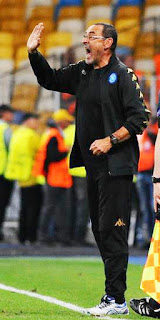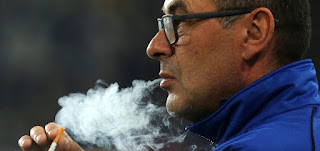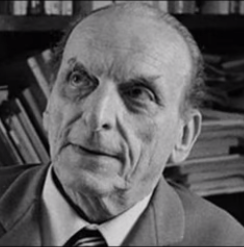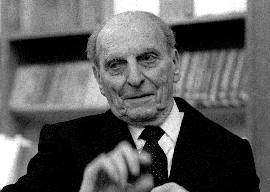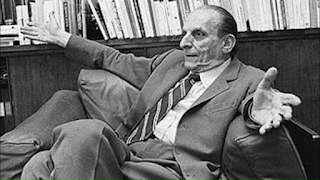Celebrated portraitist had lifelong love for Italy
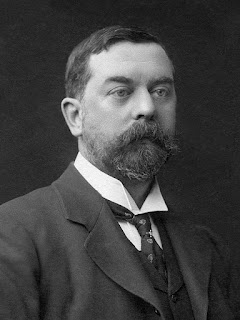 |
| John Singer Sargent, photographed in 1903 by James E Purdy |
Although he became an American citizen at the first opportunity, both his parents being American, he spent his early years in Italy and would regularly return to the country throughout his life.
At his commercial peak during the Edwardian age, his studio in London attracted wealthy clients not only from England but from the rest of Europe and even from the other side of the Atlantic, asking him to grant them immortality on canvas.
His full length portraits, which epitomised the elegance and opulence of high society at the end of the 19th century, would cost the subject up to $5,000 - the equivalent of around $140,000 (€122,000; £109,000) today.
Sargent was born in Italy on account of a cholera pandemic, the second to hit Europe that century, which caused a high number of fatalities in London in particular. His parents, who were regular visitors to Italy, were in Florence and decided it would be prudent to stay.
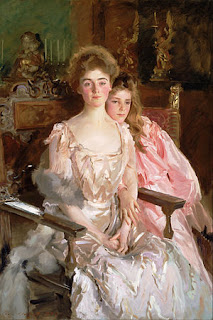 |
| A Sargent portrait of a celebrated American actress and her daughter |
Sargent’s sister, Mary, was also born in Florence and in time the family decided to stay there, his father relinquishing his position as an eye surgeon in Philadelphia.
The young Sargent did not have a formal education but learned much from his parents, quickly developing an appreciation of art, particularly in Venice, where he studied at first hand the works of Tintoretto, whom he rated an inferior only to Titian and Michelangelo.
By the age of 12, Sargent was already making his own sketches of the scenic wonders of Italy. He received his first organised art instruction from the German landscape painter, Carl Welsch, in Florence but left in 1874 to study in Paris. He was 22 before he made his first visit to the United States, and although he took the opportunity to claim his American citizenship, he immediately returned to Italy.
He spent time in Naples and Capri in 1878 before taking a studio in Venice, from which he painted many views, often of the lesser-known parts of the city and of Venetian people going about their normal daily lives. Where many painters focused on the places that attracted tourists, and did very well as a result, Sargent was more interested in the real Venice.
 |
| Sargent's impressionist-style watercolour of the Scuola di San Rocco in Venice, noted for its collection of Tintoretto paintings |
He found his own best commercial opportunities lay in Paris, and subsequently London, however, and portrait-painting became the driving force of his career.
His gift was in his ability to make each portrait somehow unique, despite the repetitive nature of the work. He managed to find something different about every sitter, could use props and background to suggest their class or occupation, and specialised in capturing his subjects in off-guard moments, rather than formal poses, to evoke a sense of their nature.
But portraits were not really what he wanted to do and, in 1910, having grown wealthy, Sargent gave up portraiture and devoted the rest of his life to painting murals and Alpine and Italian landscapes in watercolour.
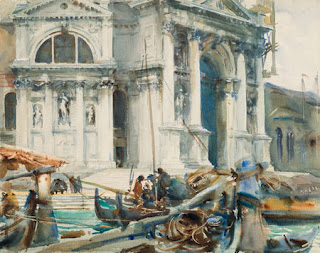 |
| Sargent's watercolour of the church of Santa Maria della Salute |
The great Baroque church of Santa Maria della Salute was one of Sargent’s favourite churches in Venice. Standing at the entrance to the Grand Canal and supported by more than a million timber piles, it was built to celebrate the city’s deliverance from the plague that claimed the lives of 46,000 Venetians in 1630. It is one of the most imposing architectural landmarks in Venice and has inspired painters such as Canaletto, Turner and Guardi. The interior consists of a large octagonal space below a cupola with eight side chapels. There are paintings by Titian and Tintoretto and a group of statues depicting the Virgin and Child expelling the plague by the Flemish sculptor, Josse de Corte.
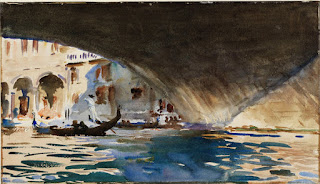 |
| Sargent's impression of a gondola passing beneath the Rialto |
The Rialto Bridge, of which Sargent sought different aspects, is the oldest of the four bridges spanning the Grand Canal in Venice, connecting the sestieri of San Marco and San Polo. Originally built as a pontoon bridge in 1181, and called Ponte della Moneta after the city’s mint, which stood near its eastern entrance, it was rebuilt several times, first in 1255, when it was replaced with a wooden bridge to cope with extra traffic generated by the development of the Rialto market. It had two inclined ramps meeting at a movable central section, that could be raised to allow the passage of tall ships. The rows of shops along the sides of the bridge were added in the first half of the 15th century. It was replaced by a stone bridge after once burning down and twice collapsing under the weight of people.
More reading:
Tintoretto, the dyer's son whose work adorns Venice
Titian, the giant of Renaissance art
The Festival of Madonna della Salute, when Venetians celebrate their deliverance from the plague
Also on this day:
1562: The birth of Charles Emmanuel I, Duke of Savoy
1751: The birth of Ferdinand I of the Two Sicilies
1848: Sicily rebels against the Bourbons
Home






